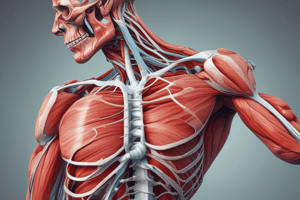Podcast
Questions and Answers
How many skeletal muscles are there in the body?
How many skeletal muscles are there in the body?
More than 600
What percentage of our body weight is skeletal muscle?
What percentage of our body weight is skeletal muscle?
From 40% to 50%
Which connective tissue component covers specialized skeletal muscle fibers?
Which connective tissue component covers specialized skeletal muscle fibers?
- Fascia
- Perimysium
- Epimysium
- Endomysium (correct)
The point of attachment that does not move when the muscle contracts is called the ______.
The point of attachment that does not move when the muscle contracts is called the ______.
What do we call a muscle or group of muscles that directly performs a specific movement?
What do we call a muscle or group of muscles that directly performs a specific movement?
What type of lever has the fulcrum lying between the pull and the load?
What type of lever has the fulcrum lying between the pull and the load?
Which of the following is NOT a factor in naming muscles?
Which of the following is NOT a factor in naming muscles?
What is the major role of muscles in terms of posture?
What is the major role of muscles in terms of posture?
Skeletal muscle is responsible for heat production.
Skeletal muscle is responsible for heat production.
What is the ability of a muscle to contract or shorten called?
What is the ability of a muscle to contract or shorten called?
What is the role of fixator muscles?
What is the role of fixator muscles?
Flashcards are hidden until you start studying
Study Notes
Skeletal Muscle Structures
- Endomysium: Delicate connective tissue membrane covering muscle fibers.
- Perimysium: Tough connective tissue binding muscle fascicles.
- Epimysium: Coarse sheath encompassing the entire muscle.
- Tendons or Aponeuroses: The three fibrous components may form tendons or aponeuroses.
- Muscle Size, Shape, and Fiber Arrangement:
- Size: Range from minuscule to extensive masses.
- Shape: Diverse shapes, including broad, narrow, long, tapering, short, blunt, triangular, quadrilateral, irregular, flat sheets, or bulky masses.
- Arrangement: Parallel to the long axis, converging to a narrow attachment, oblique, pennate, bipennate, or curved.
Muscle Attachment
- Origin: The point of attachment that remains stationary during muscle contraction.
- Insertion: The point of attachment that moves during muscle contraction.
Muscle Action
- Prime Mover: Muscle or group of muscles directly responsible for specific movement.
- Antagonist: Muscles directly opposing the prime mover's action, providing precision and control.
- Synergists: Muscles contracting simultaneously with prime movers, improving efficiency and movement.
- Fixator Muscles: Stabilize joints during movement.
Lever System
- Rigid Bar: A bone acting as a lever arm.
- Fulcrum: A joint, acting as the pivot point.
- Load: The weight or resistance being moved.
- Pull: The force exerted by the muscle.
Lever Classes
- First Class Lever: Fulcrum between the pull and the load. Less common in the human body.
- Second Class Lever: Load between the fulcrum and the pull.
- Third Class Lever: Pull between the fulcrum and the load. Most common, facilitating rapid and extensive movement.
Muscle Naming
- Naming considerations: Location, function, shape, direction of fibers, number of heads and divisions, point of attachment, and relative size.
Important Skeletal Muscles
- Muscles of Facial Expression: Unique attachment to deep skin layers of the face or neck.
- Muscles of Mastication: Responsible for chewing movements.
- Muscles that Move the Head: Paired muscles on each side of the neck, responsible for head movements.
Trunk Muscles
- Muscles of the Thorax: Vital for respiration.
- Muscles of the Abdominal Wall: Arranged in three layers with fibers running in different directions, enhancing strength.
- Muscles of the Back: Bend and stabilize the back.
- Muscles of the Pelvic Floor: Support structures within the pelvic cavity.
Upper Limb Muscles
- Muscles Acting on the Shoulder Girdle: Muscles attaching the upper extremity to the torso, located anteriorly or posteriorly.
- Muscles that Move the Upper Arm: Located around the shoulder synovial joint, allowing extensive movement.
- Muscles that Move the Forearm: Located proximally to the elbow, attaching to the ulna and radius.
- Muscles that Move the Wrist, Hand, and Fingers: Located on the anterior or posterior surfaces of the forearm.
Lower Limb Muscles
- Muscles that Move the Thigh and Lower Leg: Contribute to locomotion and stability.
- Muscles that Move the Ankle or Foot:
- Extrinsic Foot Muscles: Located in the leg and exert their actions through tendons attaching to ankle and foot bones, responsible for dorsiflexion, plantar flexion, inversion, and eversion.
- Intrinsic Foot Muscles: Located within the foot, responsible for flexion, extension, abduction, and adduction of toes.
Posture
- Good Posture: Body alignment that optimizes function and minimizes muscular effort for maintenance.
- Posture Maintenance: Muscles exert a continuous pull opposite to gravity. Structures like the nervous system, respiratory, digestive, excretory, and endocrine systems also contribute to posture.
Muscular Physiology
- General Functions of Muscles: Movement of the body or parts, heat production, and posture maintenance.
Functions of Skeletal Muscle Tissue
- Characteristics of Skeletal Muscle Cells:
- Excitability (Irritability): Ability to respond to stimuli.
- Contractility: Ability to contract, shorten, and produce movement.
- Extensibility: Ability to extend or stretch.
Studying That Suits You
Use AI to generate personalized quizzes and flashcards to suit your learning preferences.



